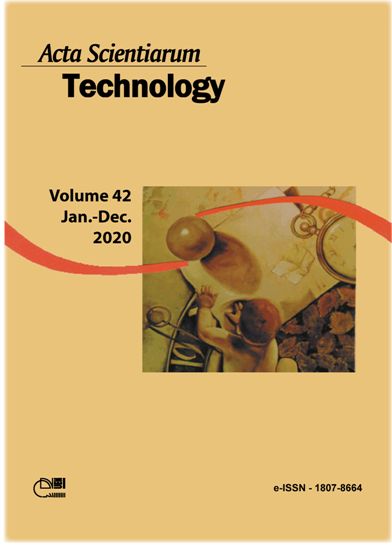In vitro and in vivo response of composites based on chitosan, hydroxyapatite and collagen
DOI:
https://doi.org/10.4025/actascitechnol.v42i1.41102Keywords:
scaffolds; tissue regeneration; immunohistochemistry; chitosan; hydroxyapatite; collagen.Abstract
The goal of this study was to evaluate the in vitro cellular toxicity and biological behavior of new bone graft composites after subcutaneous implantation during remodeling and wound-healing processes. We developed composites based on hydroxyapatite (obtained by deproteinizing bovine bone), collagen (obtained from bovine tendon) and chitosan (obtained from gladii of the squid species Loligo), that were characterized by different techniques (X-ray, FT-IR, Thermogravimetry, DSC and SEM). Three biomaterials were evaluated here: B1 (collagen/chitosan/hydroxyapatite), B2 (collagen/hydroxyapatite) B3 (collagen/hydroxyapatite). For in vitro cytotoxicity tests, two cell lines were used: HEp human larynx tumor cells (ATCC-CCL-23) and VERO cells from African green monkey (Cercopithecus aethiops). These toxicity tests demonstrated that the evaluated composites are not toxic. In biocompatibility tests, the results of a histological analysis showed that all three biomaterials present a low inflammatory tissue reaction. The tissue response was most favorable for sample B3, followed by B2 and B1, in that order. Based on these results, we conclude that all three biomaterials show good biocompatibility and no evidence of cytotoxicity; thus, these materials represent good candidates for tissue and graft engineering for use in bone regeneration.
Downloads
Downloads
Published
How to Cite
Issue
Section
License
DECLARATION OF ORIGINALITY AND COPYRIGHTS
I Declare that current article is original and has not been submitted for publication, in part or in whole, to any other national or international journal.
The copyrights belong exclusively to the authors. Published content is licensed under Creative Commons Attribution 4.0 (CC BY 4.0) guidelines, which allows sharing (copy and distribution of the material in any medium or format) and adaptation (remix, transform, and build upon the material) for any purpose, even commercially, under the terms of attribution.
Read this link for further information on how to use CC BY 4.0 properly.



















8.png)




